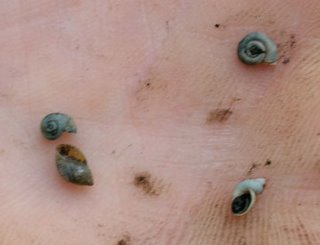Malacology
Last month, the museum where I work hired a new malacologist. Her name is Stephanie, she’s from Australia, and she most recently worked in Alabama. What’s a malacologist? It’s somebody who studies mollusks- snails, clams, mussels and other shelly creatures with soft squishy bodies and hard shells. Some mollusks, like slugs, squid, and octopi, lack shells but retain the soft, squishy characteristics. Malocologists used to be called conchologists (people who study shells), however as the field has matured, the interest has focused on the entire animal rather than just the shell, so the name got changed.
Last Friday, the part of my department that deals with the museum’s natural history collections took a malacology field trip to Bluff Spring Fen. We went because I knew that there were freshwater mussels in Poplar Creek, a moderately big stream that runs through the western edge of the preserve. For a variety of reasons, freshwater mussels are probably the most endangered group of species on the planet, so we want to know more about what we have at the Fen. Unfortunately we have had a lot of rain lately, and Poplar Creek was swollen to the point that we were unable to check out the mussels.
Since we didn’t have much luck in the creek, we thought we’d see what the fen had to offer. As usual, Bluff Spring Fen did not disappoint. The first thing we encountered was a tiger salamander eating (of all things) a piece of fungus. The weather was fairly chilly so the salamander wasn’t moving very fast and I was able to get some nice shots.

Tiger Salamander eating fungus
But we weren’t there to find amphibians, we were there to find mollusks. And find them we did- about 15 species altogether. One of the streams had dozens of tiny native clams about a quarter the size of my pinky fingernail. I’ve been going to the fen and checking out this particular stream for more than 2 decades and had no idea that they were there. Most of what we found was tiny, but it was so rewarding to be someplace that I know very well in a biological sense and find a whole world of creatures that I was unaware of.

Four tiny land snails
The last stop we made was along the stream that borders the north side of the preserve. We found the remains of a bunch of terrestrial snails that had washed into the stream. According to Stephanie, they were native species found in good wetlands. To the great amusement of all, I ended the day by slipping on the wet board and falling in the stream. Still it was the sort of day that reminds me why I enjoy the field biology aspects of what I do.

(L-R) Steve, Stephanie and Alyse check out a stream just before Doug falls in.


0 Comments:
Post a Comment
<< Home